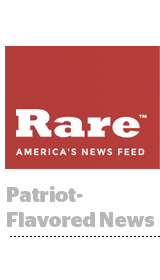 Cox Media Group’s libertarian startup site Rare recently won a showdown with old media.
Cox Media Group’s libertarian startup site Rare recently won a showdown with old media.
After Steven Tyler released his country music video on “Good Morning America,” where it got some traction, Rare linked to the video and generated 10 times the impressions: It drove 2.5 million page views in 48 hours, with an average time spent of three minutes. On Facebook, the posts generated 51,000 likes, 85,000 shares and 6,000 comments.
“We know the kind of content that works with our audience,” Rare publisher Leon Levitt said. “When we find it and hit that sweet spot, we can deliver like no one else.”
Rare’s ability to connect with a country music-loving audience is not going unnoticed by record labels. Kid Rock is releasing his next music video exclusively on Rare, which was the top traffic source for his last video release. And after driving such a high volume of traffic to Steven Tyler’s video, Rare will now work more closely with the rock star in the future.
That country-loving audience is different than what Rare originally went after. The site originated in April 2013 to counter the perception that Cox Media Group had a liberal bias and focused deeply on politics. But critics didn’t think its earliest incarnations were conservative enough.
The site struggled through two iterations before finding its optimal voice: fiscally conservative but socially liberal (pro-gay marriage and marijuana legalization), which resonates with a millennial audience. And much of its content, like Rare Country, reflects broader common interests in that group.
Now that Rare has hit its stride with content, it’s attracting a large enough audience to sell directly to advertisers and get on media plans with bigger, custom deals.
In June, it brought in 8.8 million unique visitors, according to comScore, compared to the 1.9 million uniques it got in July 2014, when comScore first started tracking it. It spiked to 11 million uniques last November and hasn’t gone below 8 million in the eight months since – which counts as consistency for a viral site dependent on Facebook traffic.
“We had to build a big enough audience in order to have enough to direct sell,” Levitt said. “I don’t want to go out and direct sell banners. Programmatic is fine for that. I want to go out and direct sell sponsorships.”
Rare hired its first salesperson in early 2014 and now employs three direct salespeople who sell integrated packages that include sponsorships, native and pre-roll.
Besides the traction in country music, the company is speaking with political campaigns. Levitt thinks Rare will be a “successful tool for politicians to get their message out,” especially because of its engaged users and scale – with the site’s political bent a secondary consideration.
Rare, which is also building sister sites focused on personal finance and sports, is nurtured by Cox Media Group but has the freedom to do things differently from its parent, Levitt said. For instance, it doesn’t have to use legacy technology or processes.
It’s also profitable, Levitt said, with programmatic revenues laying a strong foundation for the business. “It’s no longer an investment from a Cox standpoint.”
The staff grew from 10 people last June to 25 now, and Levitt expects to employ 35 to 40 people by the end of the year, including strong expansions in editorial.
As Cox Media’s publishing experiment takes off its training wheels, there’s the question of how it will grow up in the Cox family.
For one, Rare gives back: It shares some of its insights, like how to publish news for social channels, to other groups within Cox. And eventually Levitt plans for Rare’s income to be a bigger contributor to Cox’s overall business.
“It’s not going to happen in the next year, or the year after, but being bigger than the radio station and TV clusters?” Levitt said, “Those are realistic goals in the next three to four years.”














